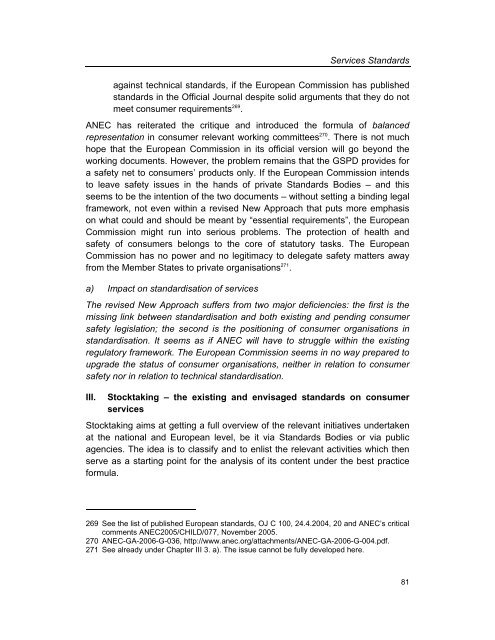Services Standards: Defining the Core Consumer Elements ... - ANEC
Services Standards: Defining the Core Consumer Elements ... - ANEC
Services Standards: Defining the Core Consumer Elements ... - ANEC
You also want an ePaper? Increase the reach of your titles
YUMPU automatically turns print PDFs into web optimized ePapers that Google loves.
<strong>Services</strong> <strong>Standards</strong><br />
against technical standards, if <strong>the</strong> European Commission has published<br />
standards in <strong>the</strong> Official Journal despite solid arguments that <strong>the</strong>y do not<br />
meet consumer requirements 269 .<br />
<strong>ANEC</strong> has reiterated <strong>the</strong> critique and introduced <strong>the</strong> formula of balanced<br />
representation in consumer relevant working committees 270 . There is not much<br />
hope that <strong>the</strong> European Commission in its official version will go beyond <strong>the</strong><br />
working documents. However, <strong>the</strong> problem remains that <strong>the</strong> GSPD provides for<br />
a safety net to consumers’ products only. If <strong>the</strong> European Commission intends<br />
to leave safety issues in <strong>the</strong> hands of private <strong>Standards</strong> Bodies – and this<br />
seems to be <strong>the</strong> intention of <strong>the</strong> two documents – without setting a binding legal<br />
framework, not even within a revised New Approach that puts more emphasis<br />
on what could and should be meant by “essential requirements”, <strong>the</strong> European<br />
Commission might run into serious problems. The protection of health and<br />
safety of consumers belongs to <strong>the</strong> core of statutory tasks. The European<br />
Commission has no power and no legitimacy to delegate safety matters away<br />
from <strong>the</strong> Member States to private organisations 271 .<br />
a) Impact on standardisation of services<br />
The revised New Approach suffers from two major deficiencies: <strong>the</strong> first is <strong>the</strong><br />
missing link between standardisation and both existing and pending consumer<br />
safety legislation; <strong>the</strong> second is <strong>the</strong> positioning of consumer organisations in<br />
standardisation. It seems as if <strong>ANEC</strong> will have to struggle within <strong>the</strong> existing<br />
regulatory framework. The European Commission seems in no way prepared to<br />
upgrade <strong>the</strong> status of consumer organisations, nei<strong>the</strong>r in relation to consumer<br />
safety nor in relation to technical standardisation.<br />
III. Stocktaking – <strong>the</strong> existing and envisaged standards on consumer<br />
services<br />
Stocktaking aims at getting a full overview of <strong>the</strong> relevant initiatives undertaken<br />
at <strong>the</strong> national and European level, be it via <strong>Standards</strong> Bodies or via public<br />
agencies. The idea is to classify and to enlist <strong>the</strong> relevant activities which <strong>the</strong>n<br />
serve as a starting point for <strong>the</strong> analysis of its content under <strong>the</strong> best practice<br />
formula.<br />
269 See <strong>the</strong> list of published European standards, OJ C 100, 24.4.2004, 20 and <strong>ANEC</strong>’s critical<br />
comments <strong>ANEC</strong>2005/CHILD/077, November 2005.<br />
270 <strong>ANEC</strong>-GA-2006-G-036, http://www.anec.org/attachments/<strong>ANEC</strong>-GA-2006-G-004.pdf.<br />
271 See already under Chapter III 3. a). The issue cannot be fully developed here.<br />
81
















